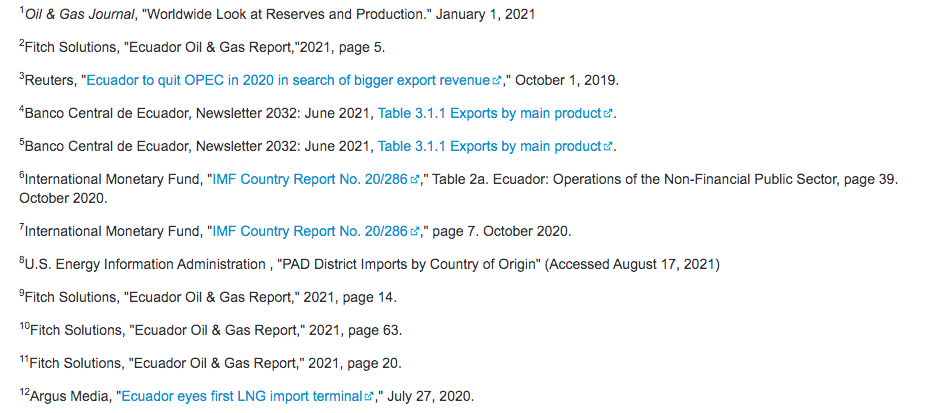Ecuador Energy Profile: Fifth-Largest Oil Producer In South America – Analysis
By EIA
In 2020, Ecuador was the fifth–largest oil producer in South America behind Brazil, Colombia, Argentina, and Venezuela.
Petroleum and other liquids represented 62% of the Ecuador’s total energy consumption in 2020. Hydroelectric power was the second–largest energy source. Natural gas and other renewable fuels account for the remainder of Ecuador’s energy mix.
Petroleum and other liquids
Reserves
As of January 2021, Ecuador had 8.3 billion barrels of proved crude oil reserves. Ecuador’ oil reserves are the third largest in Latin America, after Venezuela’s and Brazil’s reserves.1 Most of Ecuador’s oil reserves are in the Oriente Basin located in the Amazon.
Exploration and Production
The Ecuador government’s initiatives to increase the country’s share of crude oil revenue have resulted in a challenging investment environment. As a result, crude oil production stayed relatively flat between 2010 and 2020. In addition, production has continued to be limited because of less production by private companies as well as limited investment in exploration and production from new fields pursued by Petroamazonas (Ecuador’s national oil company, now called Petroecuador).2
The vast Ishping–Tambococha–Tiputini (ITT) fields are located in the Amazon region and have been subject to protests by environmental groups and indigenous communities. As a result of these protests, as well as social unrest and attacks from indigenous groups on oil infrastructure, private companies have suspended operations or have limited participation in oil production activities in the ITT fields in recent years, contributing to stagnant production growth.
Ecuador produced 483,000 barrels per day (b/d) of petroleum and other liquids in 2020, down from 534,000 b/d in 2019. In April 2020, a landslide in the Amazon region damaged the state–run Transecuatoriano’s Sistema Oleducto Trans–Ecuatoriano (SOTE) pipeline and the privately owned Oleoducto de Crudos Pesados (OCP) pipeline, forcing a force majeure. The pipeline damage disrupted crude oil production, and an estimated 60% of production was forced offline in April. Production was not fully restored until June. Petroecuador and OCP Ecuador have subsequently built bypasses for these two pipelines to avoid further disruptions in this landslide–prone area.
The COVID–19 global pandemic also contributed to a decline in crude oil production in 2020. The introduction of COVID–19 containment measures disrupted operations in the oil–rich parts of the remote eastern provinces of Ecuador and travel restrictions reduced domestic demand for refined products.
Ecuador withdrew its membership from the Organization of the Petroleum Exporting Countries (OPEC) effective January 1, 2020. According to Ecuador’s government, the country’s decision to withdraw its OPEC membership was part of the government’s rigorous plan to reduce public spending, promote public–private partnerships, and implement more market–friendly economic policies that generate new income.3
Exports and imports
According to Global Trade Tracker, Ecuador exported 360,000 b/d of crude oil in 2020. The country relies heavily on oil export revenue; in 2020, Ecuador exported over 70% of the crude oil it produced. Crude oil exports accounted for 49%4 of the country’s export earnings5 and 21%6 of public sector revenues in 2019. The country’s oil export revenues in 2020 likely decreased by half because of the decline in global oil prices due to the effects of COVID-19 lockdowns as well as because of domestic oil disruptions from the closure of the SOTE and OCP pipelines.7
In 2020, the United States received most of Ecuador’s crude oil exports, averaging 169,000 b/d, or 46% of total exports. Chile, China, and India were among the top export destinations for Ecuador’s crude oil. Ecuador was the second–largest source of foreign oil for the U.S. West Coast (PADD 5) in 2020, behind only Canada.8 Consequently, Ecuador is a regionally significant source of oil for the U.S. West Coast, which is isolated from other parts of the continental United States because of few overland pipelines.
As a result of insufficient domestic refining capacity to meet local demand, Ecuador is an importer of petroleum products, despite its production of crude oil and petroleum liquids. In general, Ecuador exports heavy refined products, such as fuel oil, and imports lighter products, including gasoline, diesel, and liquefied petroleum gas (LPG).
Pipelines
Ecuador’s pipeline infrastructure is old, and its available capacity is not fully utilized. Ecuador has two major crude oil pipeline systems. The older and more widely used pipeline is the 310–mile SOTE, which transports light to medium crude oil (Oriente crude). Ecuador’s second oil pipeline is the OCP, transporting medium and light crude oils separately from heavy crude oils (Napo crude).9 Approximately 70% of the country’s crude oil travels through SOTE, and the remainder is transported through OCP.
Ecuador has one transnational pipeline, the 190–mile Oleoducto Transandino pipeline (OTA). The 20,000 b/d OTA pipeline connects Ecuador’s oil fields with the southern Colombian port of Tumaco.10
Natural gas
Reserves
According to the Oil & Gas Journal, Ecuador had an estimated 385 billion cubic feet (Bcf) of proved natural gas reserves as of December 2020.
Production
Ecuador produces relatively small volumes of natural gas. EIA estimates that the country’s natural gas production has remained flat at 12 Bcf in 2020. Ecuador’s low natural gas production is mainly the result of a lack of the infrastructure needed to capture and market natural gas.
Natural gas production in Ecuador receives very little investment. EIA expects that the only non–associated natural gas field, the offshore Amistad field, will see a decline in output given the field’s maturity and lack of sufficient infill drilling. As of February 2021, no natural gas rigs were drilling in Ecuador, according to Baker Hughes data.11
Imports
According to media reports,12 Ecuador is considering a liquefied natural gas (LNG) to–power project as domestic natural gas production will remain insufficient to meet domestic demand. The project will include a small–scale floating LNG terminal and a floating storage and regasification unit (FSRU), which would deliver up to 50 Mcf/d to the Thermo Gas Machala natural gas–fired power plant in El Oro province.13,14 In February 2021, U.S. company Sycar was granted approval to trade LNG in Ecuador. The project is expected to come online in 2022.15
Electricity
In 2020, Ecuador generated 31 billion kilowatthours (kWh) of electricity. More than 200 power plants are operating in Ecuador, of which 89 provide power to the National Interconnected System.
Hydroelectricity accounted for 79% of the country’s electricity generation in 2020. Most of Ecuador’s existing hydroelectric capacity is located in Azuay province in the south-central highlands. In recent years, the launch of several large facilities has solidified the hydropower sector’s leading role in Ecuador’s electricity generation mix.16 The other primary source of electricity supply is oil–powered conventional thermal power plants.
Ecuador’s high use of hydropower for electricity generation leaves the country’s electric power sector vulnerable to droughts and low water levels during the dry season, which spans from October to March. To offset this, Ecuador currently relies on oil–fired plants for non–hydroelectric power supply. The government is considering converting old oil–fired plants into natural gas–fired facilities not only to meet power demand, but also to reduce costs and emissions. Although natural gas-fired generation has the potential to become a stable complementary source to drought– and erosion–susceptible hydropower, Ecuador’s lack of domestic natural gas supplies prevents expansion in the sector in the near term.
Ecuador has transmission grid interconnections with Colombia and Peru, and the country is a net importer of electricity. The government is prioritizing improvements in the transmission and distribution sector, which should reduce future challenges to the development of power and renewable projects and enable Ecuador to export more electricity.17 The residential sector accounts for approximately one–third of total electricity consumption, similar to the industrial sector.18
The non–hydro renewable energy sector in Ecuador is relatively small, contributing around 3% to total electricity generation in 2020.19 Government policy intended to increase wind and solar market penetration may result in increased non–hydro renewables generation. Some recent projects include the development of the 200–megawatt (MW) El Aromo photovoltaic solar project and the Villonaco II and III wind projects (46 MW and 56 MW, respectively).20 The startup timeline for these projects is uncertain because the tenders have been delayed twice due to the COVID–19 pandemic.
- Data presented in the text are the most recent available as of September 2021.
- Data are EIA estimates unless otherwise noted.
Endnotes



